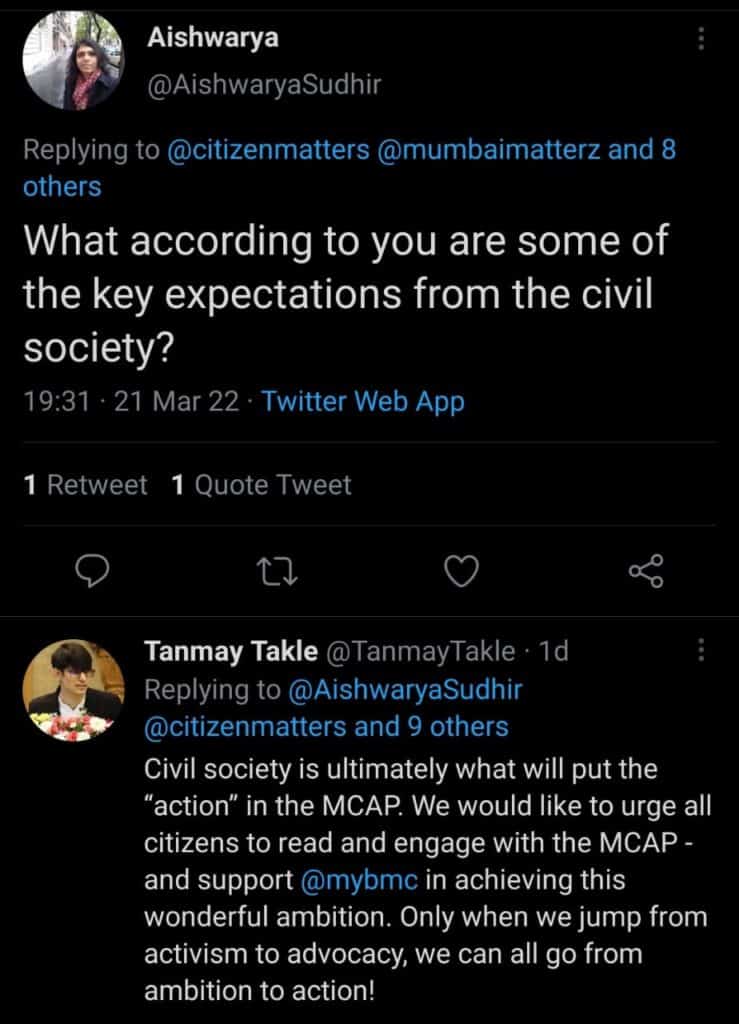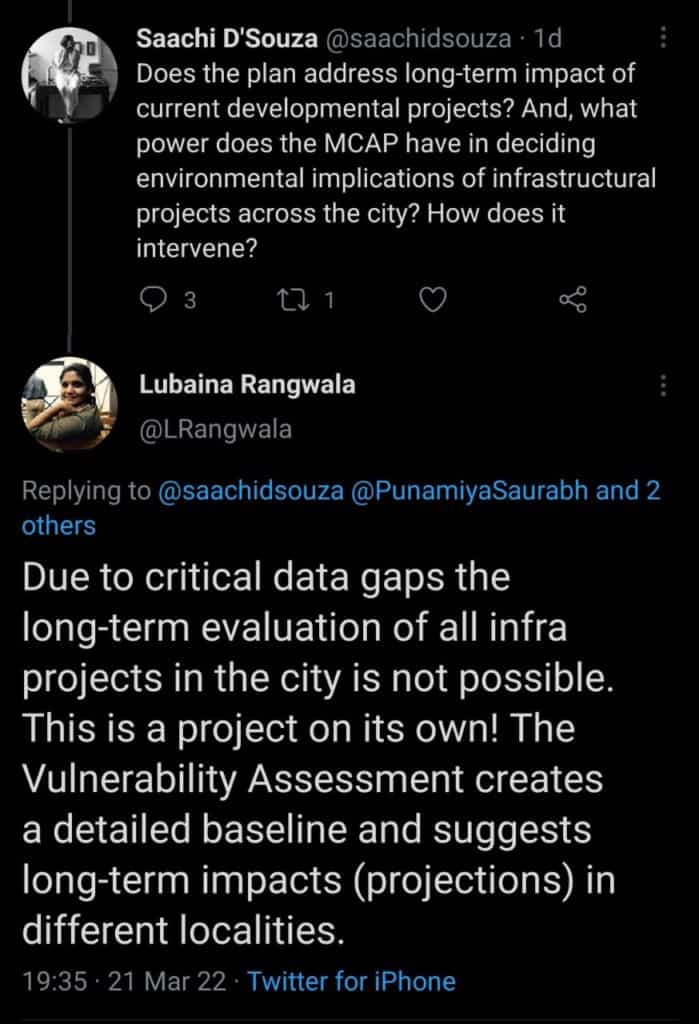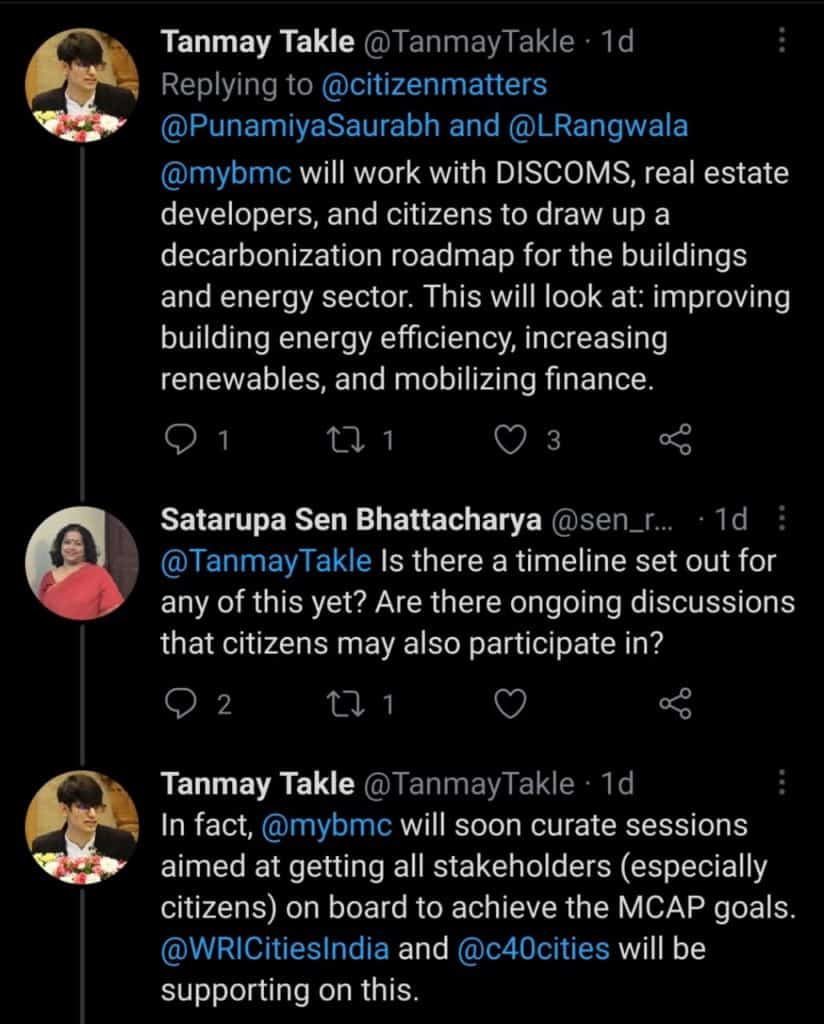On March 21st, Citizen Matters hosted a tweet chat to discuss the recently launched Mumbai Climate Plan (MCAP) with Lubaina Rangawala, Tanmay Takle and Saurabh Punamiya. After its inception in 2021, the MCAP was opened up to suggestions and criticisms from citizens, environmental experts and other stakeholders. This creates an opportunity for the city to work with the government towards an effective climate policy, as we stand at a critical juncture in Mumbai’s climate history. The tweet chat addressed points from the Plan to understand whether the Mumbai government is truly prepared for the climate crisis, and where the city currently stands in this fight.
The participants
- Lubaina is the Program Head of Urban Development and Resilience with the Sustainable Cities and Transport team at WRI India. Her current work focuses on green infrastructure projects, nature-based solutions to address long-term climate risk in Indian cities, and working with vulnerable communities to build their resilience capacities.
- Saurabh Punamiya Jain is the Research & Policy Secretary to the Minister of Environment, Tourism & Protocol, Government of Maharashtra. He is steering climate related initiatives at the BMC & the Dept of Environment, GoM under the Minister’s leadership.
- Tanmay Takle is the Partnerships & Policy Advisor to the Minister for Environment & Climate Change. He works with the Minister for Environment & Climate Change to support and manage all climate-related engagements.
How will the MCAP help change citizens’ behaviour?
Citizens can help mitigate the climate crisis through their involvement in the city’s environmental planning, and individual action, from waste segregation to reducing carbon footprints. The participants were asked how the MCAP included citizen action.

On citizen participation, Lubaina highlighted how people can help achieve goals of the MCAP. “Sustainable waste management, energy efficiency, shifting to clean fuels, sustainable mobility, walking, cycling, greening in societies with space, rainwater harvesting, the list is long!” she tweeted.

Some questions from citizens highlighted the need for consultations from citizens and other stakeholders in decisions that affect them the most. “Will citizens have a forum to raise any issues pertinent to emissions reduction or will it be project-specific only?” asked Satarupa Bhattacharya, managing editor at Citizen Matters. Lubaina and Tanmay suggested that the mcap.mcgm.gov.in website accepts feedback from citizens on all issues pertaining to the MCAP. Anyone can write to them on their ‘contact us’ page.
Can the MCAP prevent projects and policy decisions that could worsen the climate crisis?
“What power does the MCAP have in policy and infrastructural decisions of the city?” asked Sabah Virani, reporter at Citizen Matters Mumbai. Developmental projects like the coastal road, flyovers, etc, could potentially cause more damage to Mumbai’s environment, and criticisms towards them have only risen in the past few years.
“MCAP clearly lays out the vulnerabilities of Mumbai and it adds a climate lens to the city’s development plan. Primary projects that form baseline infrastructure will be carried out but everything will be subject to offsetting measures at the very least,” said Saurabh Punamiya in response.

On localising offsetting measures, Satarupa asked, “Can emissions in Deonar be offset by planting a tree in a distant part of the city?”
“When one speaks about offsets it need not always mean planting trees. That’s what MCAP challenges as well. Let’s say you’re building a metro station which is carbon intensive, but can it’s roof tops have solar panels? This design thinking is the kind of offset principle we look at,” said Saurabh.
“All tree planting efforts under MCAP are focused on resilience, not mitigation, to avoid maladaptation. The Vulnerability Assessment will help identify high heat risk and flood risk areas where greening and nature-based solutions are critical. These may account as offsets not necessary,” Lubaina added.
Read more: Is concretisation killing trees in Mumbai?
How will the MCAP bring sustainability in the energy and building sectors?
The energy and buildings sectors contribute to 71% of greenhouse gases in the city. The speakers were asked to expand on how the MCAP addresses this in the next leg of the chat that focused on plans to engage and incentivise industries and building sectors to move to sustainable practices.

“Much of the energy used by electric cars is still derived from coal. How does does the MCAP plan to shift towards renewable energy?” asked Sabah. According to Lubaina, the only way to achieve net zero by 2050 is to decarbonise the energy grid. This will require initiative from the central and state government, and a ‘value-chain approach’ to decarbonise the buildings sector.
How does the MCAP address climate change impact in informal settlements/slums?
Given poor infrastructure and lack of access to basic services, slum residents are inevitably more vulnerable to climate change than wealthier homes in the city. The speakers were asked to comment on whether the MCAP includes the needs of slum areas.
According to Tanmay and Lubaina, slums and informal settlements are key areas of action. “Meeting the sanitation needs in informal settlements is not a direct climate challenge, but essential, to provide safety and resilience in the long-term. It is established as a clear goal by experts in stakeholder consultations in September 2021,” said Lubaina.
“The MCAP outlines multiple short, medium and long-term actions focused on building resilience in informal settlements. Some of these include 100% waste segregation at source, improved energy efficiency, and access to clean cooking,” elaborated Tanmay.
How does the MCAP address plastic usage in the city?
Despite the plastic ban, put in place from 2019, Mumbai generates 26,000 tonnes of plastic waste every day. The speakers were asked about how the MCAP planned to address and combat this.

“An ambitious initiative like the MCAP needs active citizen participation and government support. “Only when we jump from activism to advocacy, we can all go from ambition to action,” said Tanmay, to conclude the discussion.